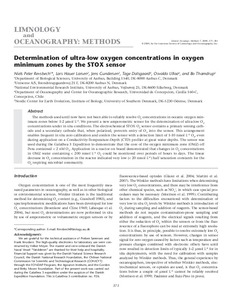Determination of ultra-low oxygen concentrations in oxygen minimum zones by the STOX sensor.

View/
Average rating
votes
Date
2009Author
Revsbech, Niels Peter
Larsen, Lars Hauer
Gundersen, Jens
Dalsgaard, Tage
Ulloa, Osvaldo
Thamdrup, Bo
Metadata
Show full item recordAbstract
The methods used until now have not been able to reliably resolve O2 concentrations in oceanic oxygen minimum zones below 1–2 µmol L−1. We present a new amperometric sensor for the determination of ultra‐low O2 concentrations under in situ conditions. The electrochemical STOX O2 sensor contains a primary sensing cathode and a secondary cathode that, when polarized, prevents entry of O2 into the sensor. This arrangement enables frequent in situ zero calibration and confers the sensor with a detection limit of 1‐10 nmol L−1 O2, even during application on a Conductivity‐Temperature‐Depth (CTD) profiler at great water depths. The sensor was used during the Galathea 3 Expedition to demonstrate that the core of the oxygen minimum zone (OMZ) off Peru contained < 2 nM O2. Application in a reactor on board demonstrated that changes in O2 concentrations in OMZ water containing < 200 nmol L−1 O2 could be monitored over periods of hours to days. The linear decrease in O2 concentration in the react.....
Journal
Limnology and Oceanography: MethodsVolume
7Page Range
pp.371-381Document Language
enEssential Ocean Variables (EOV)
OxygenMaturity Level
TRL 8 Actual system completed and "mission qualified" through test and demonstration in an operational environment (ground or space)Best Practice Type
Standard Operating ProcedureDOI Original
https://doi.org/10.4319/lom.2009.7.371Citation
Revsbech, N. P.; Larsen, L. H.; Gundersen, J.; Dalsgaard, T.; Ulloa, O. and Thamdrup, B. ( 2009) Determination of ultra‐low oxygen concentrations in oxygen minimum zones by the STOX sensor. Limnology and Oceanography: Methods, 7, pp.371-381. DOI:10.4319/lom.2009.7.371.Collections
 Repository of community practices in Ocean Research, Applications and Data/Information Management
Repository of community practices in Ocean Research, Applications and Data/Information Management